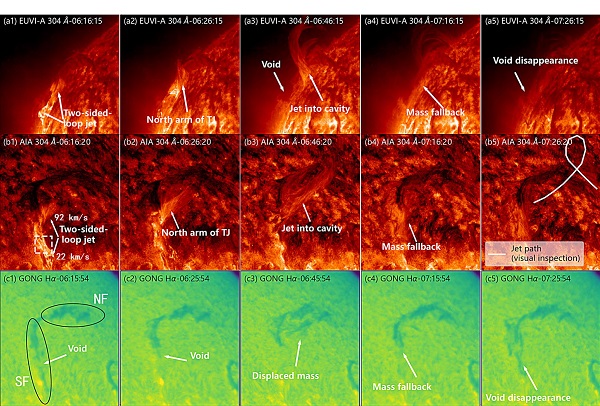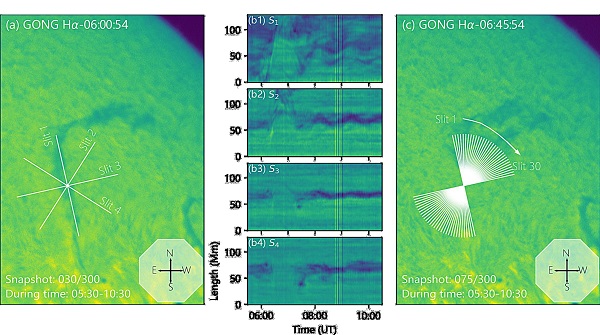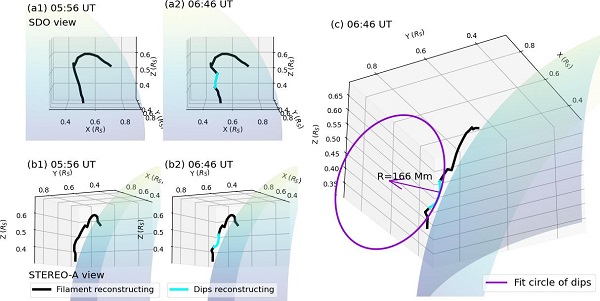Recently, the Site Selection and Coronal Observation Group of the Yunnan Observatories of the Chinese Academy of Sciences (CAS) have obtained new observations in the study of large amplitude filament oscillations. The research was carried out by MSc student TAN Song and his supervisor, Professor SHEN Yuan-Deng, and was published in the Journal of the Royal Astronomical Society (MNRAS).
Filaments are composed of cold plasma material suspended in the solar atmosphere and appear as dark absorbing structures, whose magnetic information is crucial to our understanding of the formation, stability and eruption of filaments. A preliminary exploration of jet-filament interactions has been previously carried out by TAN Song et al. by means of the motion of a two-sided-loop jet in the magnetic rope structure of a filament-coronal cavity (link to Paper 1). Continuing their previous work, they turned their attention to the large-amplitude filament oscillation triggered by two-sided-loop jet and carefully analyzed the nature of this large-amplitude oscillation with the help of joint observations from the Solar Dynamics Observatory (SDO), Solar Terrestrial Relations Observatory (STEREO) and Global Solar Oscillation Detection Network (GONG).
The researchers studied the oscillations of a large filament on 29 November 2011. They found that the two-sided-loop jet generated at the southern foot of the filament first moved northwards along the magnetic lines which form the coronal cavity, then pushed a part of the filament material up and back down before starting to oscillated longitudinally at the bottom of the coronal cavity (magnetic dips). At the same time, the northern part of the filament began to oscillate transversely. The amplitude and period of the longitudinal (transverse) oscillations were 12.96 (2.99) Mm and 1.18 (0.33) h, respectively. The radius of curvature at the base of the magnetic dips was obtained by using the seismology method to be about 151 Mm, which was in good agreement with the innovative three-dimensional reconstruction of the directly “seen” magnetic depressions (166 Mm). The magnetic field strengths of the northern and southern parts of the filament were also diagnosed at 23 and 21 Gauss, respectively, which also diagnosed the lower limit of the jet energy. The researchers suggested that the newly formed jets can not only trigger simultaneous longitudinal and lateral oscillations in a single filament, but can also be used as a seismological tool to diagnose information about the filaments (e.g. magnetic structure, magnetic field strength and magnetic twists).
This work continues the group's work on filament oscillations and two-sided-loop jets, and combines them into the first three-dimensional observation of simultaneous longitudinal and transverse oscillations of a single filament, which also enriches the observational results of filament oscillation studies and paves the way for further research.
This work was supported by the National Natural Science Foundation of China, the Distinguished Youth Fund of Yunnan Province and the Key Laboratory of Solar Physics and Space Target Monitoring of Yunnan Province.
Contact:
TAN Song
Yunnan Observatories, CAS
Email: tansong@ynao.ac.cn

Figure 1: Joint SDO, STEREO and GONG observations of the target filament, with the motion of the studied two-sided-loop jets indicated by markers in the figure.

Figure 2: The all-disk Ha image of GONG is used to analyze the longitudinal oscillation behavior of the target filament and to accurately determine the true oscillation direction (ignoring the projection effect).

Figure 3: The radius of curvature of the bottom of the magnetic dips directly "seen" by the jet motion, using a three-dimensional reconstruction.